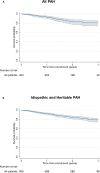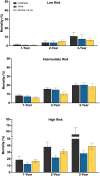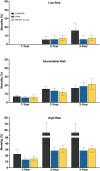Mortality in Pulmonary Arterial Hypertension in the Modern Era: Early Insights From the Pulmonary Hypertension Association Registry
- PMID: 35475351
- PMCID: PMC9238604
- DOI: 10.1161/JAHA.121.024969
Mortality in Pulmonary Arterial Hypertension in the Modern Era: Early Insights From the Pulmonary Hypertension Association Registry
Abstract
Background Current mortality data for pulmonary arterial hypertension (PAH) in the United States are based on registries that enrolled patients prior to 2010. We sought to determine mortality in PAH in the modern era using the PHAR (Pulmonary Hypertension Association Registry). Methods and Results We identified all adult patients with PAH enrolled in the PHAR between September 2015 and September 2020 (N=935). We used Kaplan-Meier survival analysis and Cox proportional hazards models to assess mortality at 1, 2, and 3 years. Patients were stratified based on disease severity by 3 validated risk scores. In treatment-naïve patients, we compared survival based on initial treatment strategy. The median age was 56 years (44-68 years), and 76% were women. Of the 935 patients, 483 (52%) were ≤6 months from PAH diagnosis. There were 121 deaths (12.9%) during a median follow-up time of 489 days (281-812 days). The 1-, 2-, and 3-year mortality was 8% (95% CI, 6%-10%), 16% (95% CI, 13%-19%), and 21% (95% CI, 17%-25%), respectively. When stratified into low-, intermediate-, and high-risk PAH, the mortality at 1, 2, and 3 years was 1%, 4% to 6%, and 7% to 11% for low risk; 7% to 8%, 11% to 16%, and 18% to 20% for intermediate risk; and 12% to 19%, 22% to 38%, and 28% to 55% for high risk, respectively. In treatment-naïve patients, initial combination therapy was associated with better 1-year survival (adjusted hazard ratio, 0.43 [95% CI, 0.19-0.95]; P=0.037). Conclusions Mortality in the intermediate- and high-risk patients with PAH remains unacceptably high in the PHAR, suggesting the importance for early diagnosis, aggressive use of available therapies, and the need for better therapeutics.
Keywords: United States; pulmonary hypertension; right ventricle; survival; vasodilators.
Figures





References
Publication types
MeSH terms
Grants and funding
LinkOut - more resources
Full Text Sources
Medical

